Biolaminin 511 LN (LN511)
Human recombinant laminin 511
Biolaminin 511 is the natural laminin for mouse embryonic stem cells and allows sustained pluripotency without the need to use feeder cells or differentiation inhibitors like LIF.
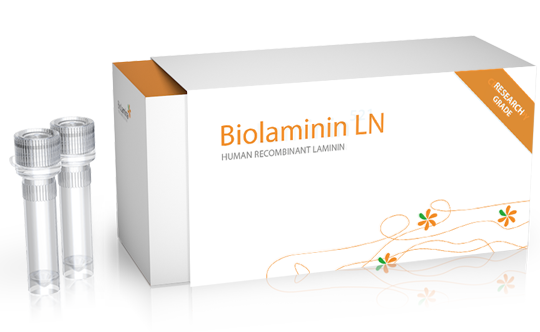
Biorelevant microenvironment keeps mouse stem cells pluripotent for months
The need for matrices that support pluripotent stem cell renewal in a reproducible manner is clear. Stem cell biologists have long experienced problems with the repeatability of results and with the maintenance of pluripotency when working with ES cell cultures.
Laminin 511, together with laminin 521, are the most widely expressed laminins in the body. Stem cells grow as monolayers on LN511 enabling equal contact to both the matrix and cell culture medium, which leads to a more homogenous cell population. Since Biolaminin 511 is a recombinant protein, lot-to-lot variation is minimal, and therefore fewer replicates are needed for reliable results (Domogatskaya, 2008; Rodin, 2010).
Biolaminin 511 matrix creates a biological niche keeping mouse ES cells in a pluripotent state for months. Biolaminin 511 is a full-length human recombinant laminin that is used as a mouse ESC or iPSC culture substrate.
Biolaminin 511 is especially recommended for the cell culture of murine embryonic and induced pluripotent stem cells, while LN521 is recommended for the culture of human stem cells.
Biolaminin 511 supports human epithelial cell culture
Laminin 511 is an important regulator of hair development and an adhesion molecule for human epidermal keratinocytes supporting cell survival and growth (Yap, 2019). Laminin 511 is one of the laminins present in Bruch’s membrane located beneath the retinal pigment epithelium in the eye. Full-length laminin 511 has been shown to allow ex vivo expansion of human limbal epithelial cells of the cornea (Shibata, 2018). Precoating with Biolaminin 511 was also shown to promote the functional recovery of transplanted corneal endothelial cells (CECs) (Zhao, 2020).
Biolaminin 511 allows robust and easy long-term expansion of primary adult human dermal keratinocytes in a defined and animal-origin free manner (Tjin, 2018). Keratinocyte culture was comparable to the 3T3-J2 feeder co-culture system, in terms of colony-forming efficiency, basal marker profile, genetic stability and the ability to form normal stratified epidermal structure in both in vitro and in vivo models. Keratinocyte cells cultivated on Biolaminin 511 also demonstrate a significantly reduced pro-inflammatory signalling pathway expressions compared to classical feeder culture-based systems.
Organotypic culture shows that human keratinocytes cultured on Biolaminin 511 are able to form a normal stratified epidermal structure in vitro, forming a normal epidermal skin layer with stratum corneum, stratum granulosum, stratum spongiosum, and stratum basal similar to that of a normal skin. (Tjin 2020, Tjin 2018)
Recommended applications
-
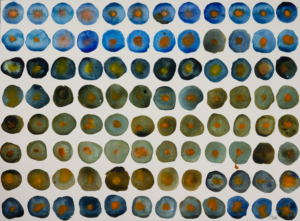
Stem cells of animal origin
Biorelevant culture of animal stem cells on Biolaminin substrates The laminin protein family is highly conserved Laminins are a large family of […]View application -
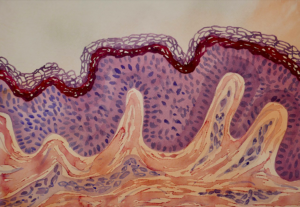
Skin cells
Biorelevant culture of keratinocytes on Biolaminin substrates The basement membrane composition in the epidermis Human epidermal keratinocyte (HEK) cells are […]View application -
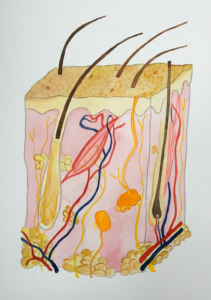
Hair follicle cells
Biorelevant culture of hair follicle stem cells on Biolaminin substrates Epithelial tissues contain a-5 and a-3 laminin isoforms Epithelial tissues are […]View application -
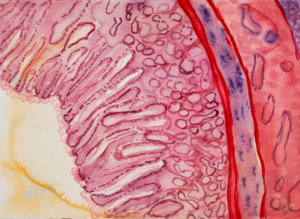
Intestinal cells
Biorelevant culture of intestinal cells on Biolaminin substrates Laminin expression in the intestine The small intestine contains mucosal epithelial invaginations called […]View application -
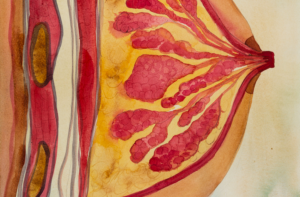
Mammary gland cells
Biorelevant culture of human mammary cells on Biolaminin substrates Laminins have both overlapping and unique functions in the mammary gland tissue Mammary […]View application -
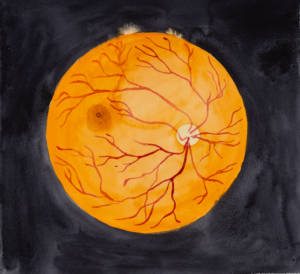
Eye cells
Biorelevant culture of eye cells Laminin proteins are important components in the eye microenvironment Biolaminin products have been succesfully used […]View application
Key features
Improved culture environment
Biolaminin 511 allows the proliferation of pluripotent mouse ES cells without differentiation inhibitors or feeder cells. Importantly, the ES cells grow as a homogenous monolayer, which ensures equal availability to both substrate and soluble factors and, thus, creates a more homogenous cell population (Domogatskaya, 2008). The LN511 matrix provides better opportunities for designing experiments and interpreting obtained results.
LN511 and other laminins can also be applied to glass, and as stem cells grow as a monolayer on LN511 and LN521 these laminins have been used for improved imaging of stem cells grown on glass slides.
mESC expansion without LIF
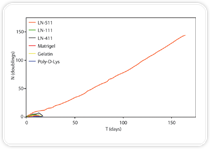
LN511 support the self-renewal of mouse ES cells for over 5 months without the presence of LIF or feeder cells, when other known matrices are unable to do so for longer than a couple of weeks.
Homogenous monolayer
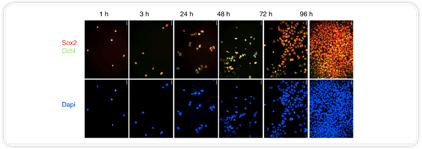
Mouse ES cells adhere to LN511 with three to five-fold higher affinity than to other commonly used matrices. Pluripotent mouse ES cells grow even at low cell density as monolayers on the surface of LN511, which is different from the conventional clusters in the cultures, and, therefore, have equal contact with the matrix and medium, allowing a homogeneous and defined growth environment.
Long-term pluripotent mouse ES cells
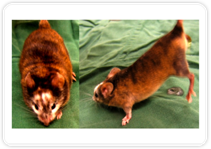
Mouse ES cells grown on LN511 for over 3 months are indeed pluripotent since they give rise to germline transmission (chimeric mice) after injection into mouse blastocysts.
Coating plates
1. Slowly thaw recombinant laminins at +4°C before use.
2. Dilute the thawed laminin stock solution with 1xDPBS containing Ca2+ and Mg2+.
3. Add the diluted laminin solution to tissue culture-treated cultureware for a final coating concentration of 0.5-2 µg/cm2. The optimal coating concentration is cell line-dependent.
4. Seal the plate (e.g. with Parafilm®) to prevent evaporation and incubate at +2°C to +8°C overnight. If a more rapid coating is required, incubate at +37°C for 2 hours. Make sure the laminin solution is spread evenly across the surface. Note that the laminin matrix will be inactivated if let dry.
Passage mouse PSCs on LN511
1. Aspirate old medium from wells.
2. Wash the cells gently with 1xDPBS (Ca2+/Mg2+) and aspirate, add TrypLE to wells and incubate at room temperature for max 30 seconds.
3. Aspirate TrypLE, and wash the cells twice with a pre-warmed medium.
4. Add fresh medium to wells. Scrape cells with a pipette tip, then gently pipette up and down to achieve a clump size of approximately 0.5 -1 mm in diameter. Avoid making a single-cell suspension.
5. Seed cells with a ratio of 1:2, 1:3 or 1:4 on LN511 coated wells. Optimal seeding densities will vary from one cell line to another and can be determined empirically.
Important notes
- The laminin stock solution is long-term stable when stored at -20°C to -80°C. Please refer to the product-specific CoA for shelf life details.
- Repeated freeze-thawing should be avoided. If desired, the laminin stock can be dispensed into working aliquots and stored at -20°C to -80°C. Thawed, undiluted laminin stock is stable for at least 3 months when stored at +2°C to +8°C under aseptic conditions.
- Avoid long exposure of the protein to ambient temperatures.
- For your convenience, the coated plates can be kept for up to 4 weeks when stored aseptically at +2°C to +8°C.
- When culturing mouse PSCs on LN511 no treatment with differentiation inhibitors, such as leukemia inhibitory factor (LIF), is needed.
- The protocol can easily be made totally defined and animal origin-free with your choice of culture medium and enzyme.
- Before start, all solutions used for cell passaging should be aliquoted in sufficient amounts and pre-warmed at +37°C, 5% CO2.
- Cells are ready to be passaged when cell culture is ≥60% confluent. Optimal seeding densities will vary from one cell line to another and can be determined empirically for your system. With optimal media conditions and seeding density, most cell lines will reach confluence within 4-6 days and expand 10-25 fold.
- When moving your cells from another feeder-free matrix (e.g. Matrigel) we recommend you to start smaller well format (e.g. 96-well or 48-well format) and a higher seeding density (50,000-100,000 cells/cm2) for the first number of passages to let the cells adapt to the laminin matrix before increasing the culture well format and lowering the seeding density.
Product name
Biolaminin 511 LN
Product code
LN511-0202
LN511-0502
Declaration
For research use only
Storage
-20°C to -80°C
Concentration
0.1 mg/ml
Appearance
Clear, colorless, buffered solution with a pH of 7.2 with 10% glycerol and 0.02% NaN3
Shipping condition
Dry Ice
Protein name
Laminin 511 (Laminin-10)
Classification
Animal origin-free, human recombinant protein
Product application
Cell culture of murine embryonic and induced pluripotent stem cells
Laminin-511 but not -332, -111, or -411 enables mouse embryonic stem cell self-renewal in vitro
Domogatskaya A, Rodin S, Boutaud A, Tryggvason K.
Stem Cells, 2008
Long-term self-renewal of human pluripotent stem cells on human recombinant laminin-511
Rodin S, domogatskaya A, Ström S, Hansson EM, Chien KR, Inzunza J, Hovatta O, Tryggvason K.
Nature Biotechnology, 2010
Compositional and structural requirements for laminin and basement membranes during mouse embryo implantation and gastrulation
Miner JH, Li C, Mudd JL, Go G, Sutherland AE.
Development, 2004
Trophoblast-specific expression and function of the integrin alpha 7 subunit in the peri-implantation mouse embryo
Klaffky E,Williams R,Yao CC, Ziober B, Kramer R, Sutherland AE.
Developmental Biology, 2001
Xeno-free culture of human pluripotent stem cells
Bergström R, Ström S, Holm F, Feki A, Hovatta O
Methods Mol Biol, 2011
Size guide
Not sure how much laminin you need? To make it easy, we have created a tool where you can calculate the amount needed for your experiments. Just choose culture well format and fill in the desired coating concentration to see the amount required.
Please see the coating instructions for concentration and volume guidelines.